Strategies for Working with Diverse People: A Case Study Analysis
VerifiedAdded on 2022/10/02
|7
|1572
|210
Report
AI Summary
This report examines the complexities of working with diverse individuals in a workplace setting, addressing issues of cultural differences, communication barriers, and conflict resolution. The assignment presents three case studies. The first case explores a situation where cultural misunderstandings led to conflict between African-American and white employees. The second case examines the challenges faced by an aboriginal woman in an aged care setting, highlighting issues of language, cultural norms, and the need for inclusive care. The third case study focuses on communication difficulties between Chinese patients and healthcare professionals due to differing cultural expectations regarding non-verbal cues, gender roles, and medical practices. The report analyzes these scenarios, providing recommendations for open-mindedness, flexibility, and the importance of embracing diversity to foster effective communication and create an inclusive environment. The assignment underscores the need for understanding and adapting to diverse cultural perspectives in order to achieve successful outcomes.
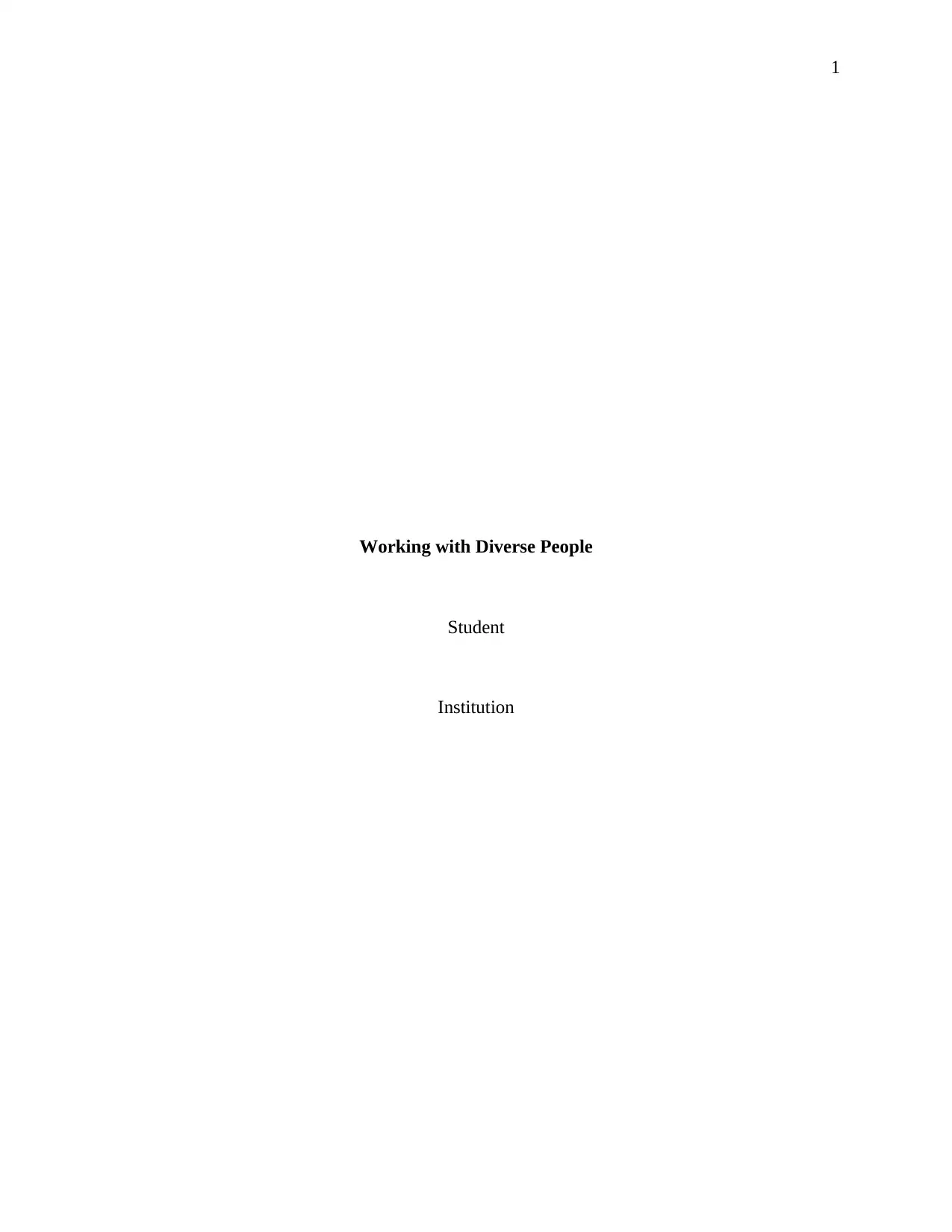
1
Working with Diverse People
Student
Institution
Working with Diverse People
Student
Institution
Secure Best Marks with AI Grader
Need help grading? Try our AI Grader for instant feedback on your assignments.
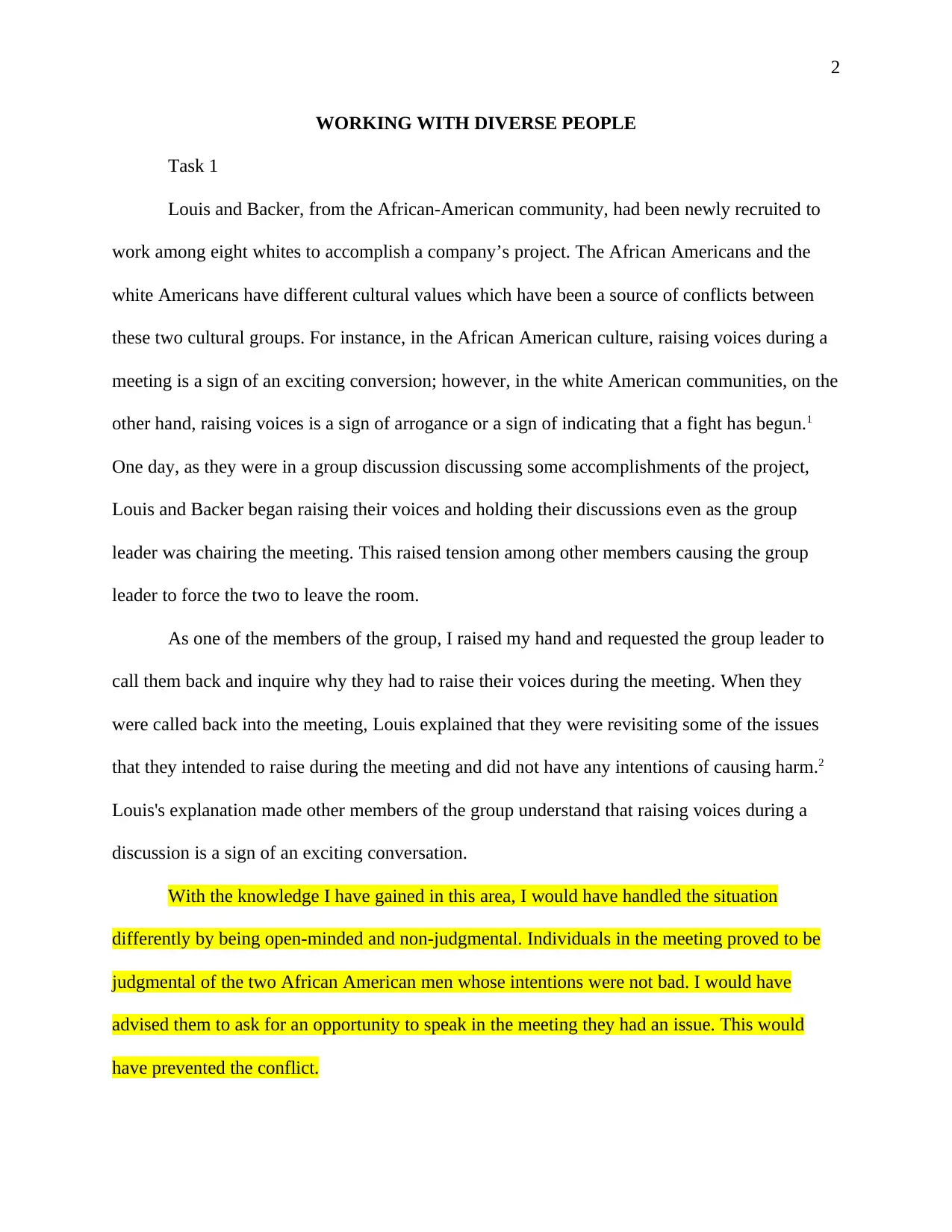
2
WORKING WITH DIVERSE PEOPLE
Task 1
Louis and Backer, from the African-American community, had been newly recruited to
work among eight whites to accomplish a company’s project. The African Americans and the
white Americans have different cultural values which have been a source of conflicts between
these two cultural groups. For instance, in the African American culture, raising voices during a
meeting is a sign of an exciting conversion; however, in the white American communities, on the
other hand, raising voices is a sign of arrogance or a sign of indicating that a fight has begun.1
One day, as they were in a group discussion discussing some accomplishments of the project,
Louis and Backer began raising their voices and holding their discussions even as the group
leader was chairing the meeting. This raised tension among other members causing the group
leader to force the two to leave the room.
As one of the members of the group, I raised my hand and requested the group leader to
call them back and inquire why they had to raise their voices during the meeting. When they
were called back into the meeting, Louis explained that they were revisiting some of the issues
that they intended to raise during the meeting and did not have any intentions of causing harm.2
Louis's explanation made other members of the group understand that raising voices during a
discussion is a sign of an exciting conversation.
With the knowledge I have gained in this area, I would have handled the situation
differently by being open-minded and non-judgmental. Individuals in the meeting proved to be
judgmental of the two African American men whose intentions were not bad. I would have
advised them to ask for an opportunity to speak in the meeting they had an issue. This would
have prevented the conflict.
WORKING WITH DIVERSE PEOPLE
Task 1
Louis and Backer, from the African-American community, had been newly recruited to
work among eight whites to accomplish a company’s project. The African Americans and the
white Americans have different cultural values which have been a source of conflicts between
these two cultural groups. For instance, in the African American culture, raising voices during a
meeting is a sign of an exciting conversion; however, in the white American communities, on the
other hand, raising voices is a sign of arrogance or a sign of indicating that a fight has begun.1
One day, as they were in a group discussion discussing some accomplishments of the project,
Louis and Backer began raising their voices and holding their discussions even as the group
leader was chairing the meeting. This raised tension among other members causing the group
leader to force the two to leave the room.
As one of the members of the group, I raised my hand and requested the group leader to
call them back and inquire why they had to raise their voices during the meeting. When they
were called back into the meeting, Louis explained that they were revisiting some of the issues
that they intended to raise during the meeting and did not have any intentions of causing harm.2
Louis's explanation made other members of the group understand that raising voices during a
discussion is a sign of an exciting conversation.
With the knowledge I have gained in this area, I would have handled the situation
differently by being open-minded and non-judgmental. Individuals in the meeting proved to be
judgmental of the two African American men whose intentions were not bad. I would have
advised them to ask for an opportunity to speak in the meeting they had an issue. This would
have prevented the conflict.
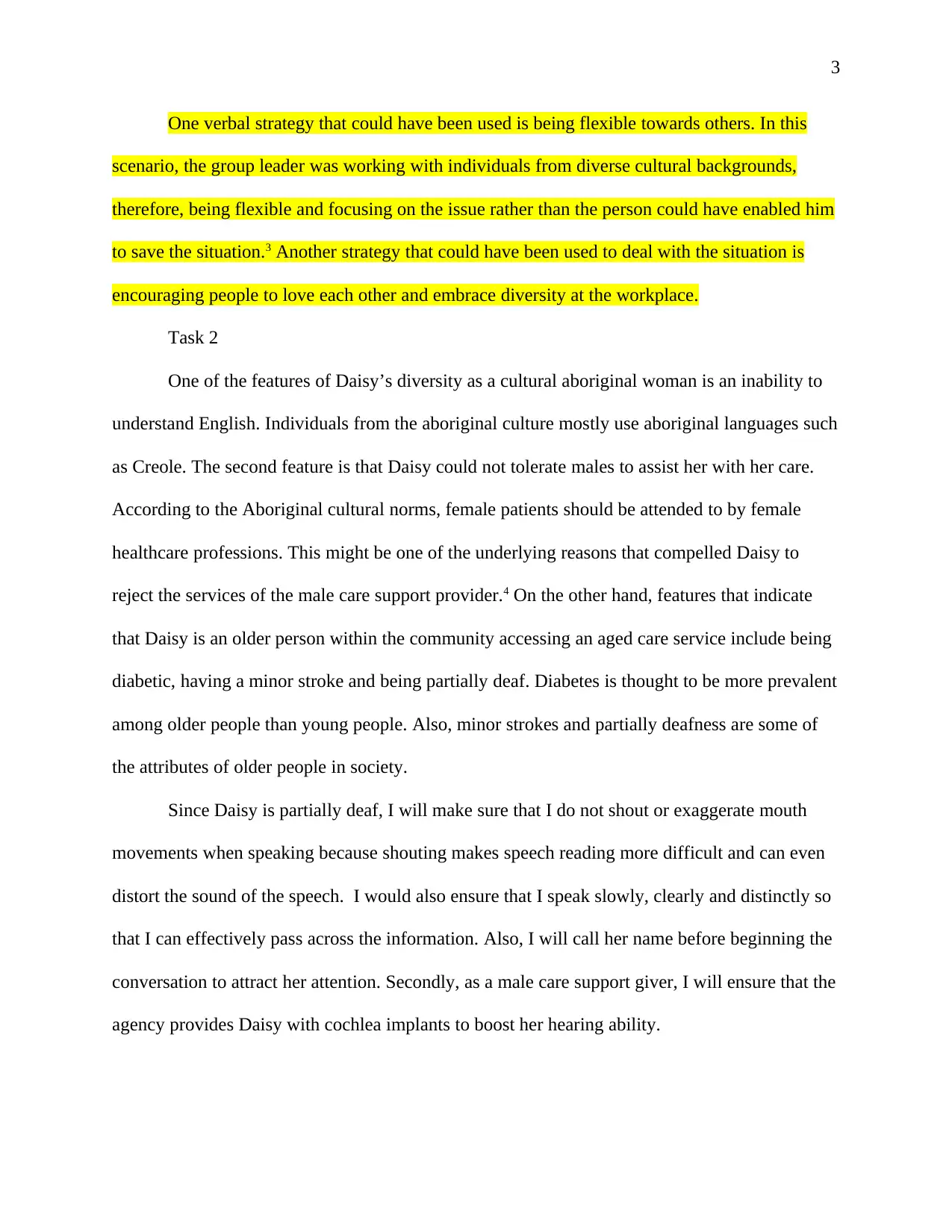
3
One verbal strategy that could have been used is being flexible towards others. In this
scenario, the group leader was working with individuals from diverse cultural backgrounds,
therefore, being flexible and focusing on the issue rather than the person could have enabled him
to save the situation.3 Another strategy that could have been used to deal with the situation is
encouraging people to love each other and embrace diversity at the workplace.
Task 2
One of the features of Daisy’s diversity as a cultural aboriginal woman is an inability to
understand English. Individuals from the aboriginal culture mostly use aboriginal languages such
as Creole. The second feature is that Daisy could not tolerate males to assist her with her care.
According to the Aboriginal cultural norms, female patients should be attended to by female
healthcare professions. This might be one of the underlying reasons that compelled Daisy to
reject the services of the male care support provider.4 On the other hand, features that indicate
that Daisy is an older person within the community accessing an aged care service include being
diabetic, having a minor stroke and being partially deaf. Diabetes is thought to be more prevalent
among older people than young people. Also, minor strokes and partially deafness are some of
the attributes of older people in society.
Since Daisy is partially deaf, I will make sure that I do not shout or exaggerate mouth
movements when speaking because shouting makes speech reading more difficult and can even
distort the sound of the speech. I would also ensure that I speak slowly, clearly and distinctly so
that I can effectively pass across the information. Also, I will call her name before beginning the
conversation to attract her attention. Secondly, as a male care support giver, I will ensure that the
agency provides Daisy with cochlea implants to boost her hearing ability.
One verbal strategy that could have been used is being flexible towards others. In this
scenario, the group leader was working with individuals from diverse cultural backgrounds,
therefore, being flexible and focusing on the issue rather than the person could have enabled him
to save the situation.3 Another strategy that could have been used to deal with the situation is
encouraging people to love each other and embrace diversity at the workplace.
Task 2
One of the features of Daisy’s diversity as a cultural aboriginal woman is an inability to
understand English. Individuals from the aboriginal culture mostly use aboriginal languages such
as Creole. The second feature is that Daisy could not tolerate males to assist her with her care.
According to the Aboriginal cultural norms, female patients should be attended to by female
healthcare professions. This might be one of the underlying reasons that compelled Daisy to
reject the services of the male care support provider.4 On the other hand, features that indicate
that Daisy is an older person within the community accessing an aged care service include being
diabetic, having a minor stroke and being partially deaf. Diabetes is thought to be more prevalent
among older people than young people. Also, minor strokes and partially deafness are some of
the attributes of older people in society.
Since Daisy is partially deaf, I will make sure that I do not shout or exaggerate mouth
movements when speaking because shouting makes speech reading more difficult and can even
distort the sound of the speech. I would also ensure that I speak slowly, clearly and distinctly so
that I can effectively pass across the information. Also, I will call her name before beginning the
conversation to attract her attention. Secondly, as a male care support giver, I will ensure that the
agency provides Daisy with cochlea implants to boost her hearing ability.
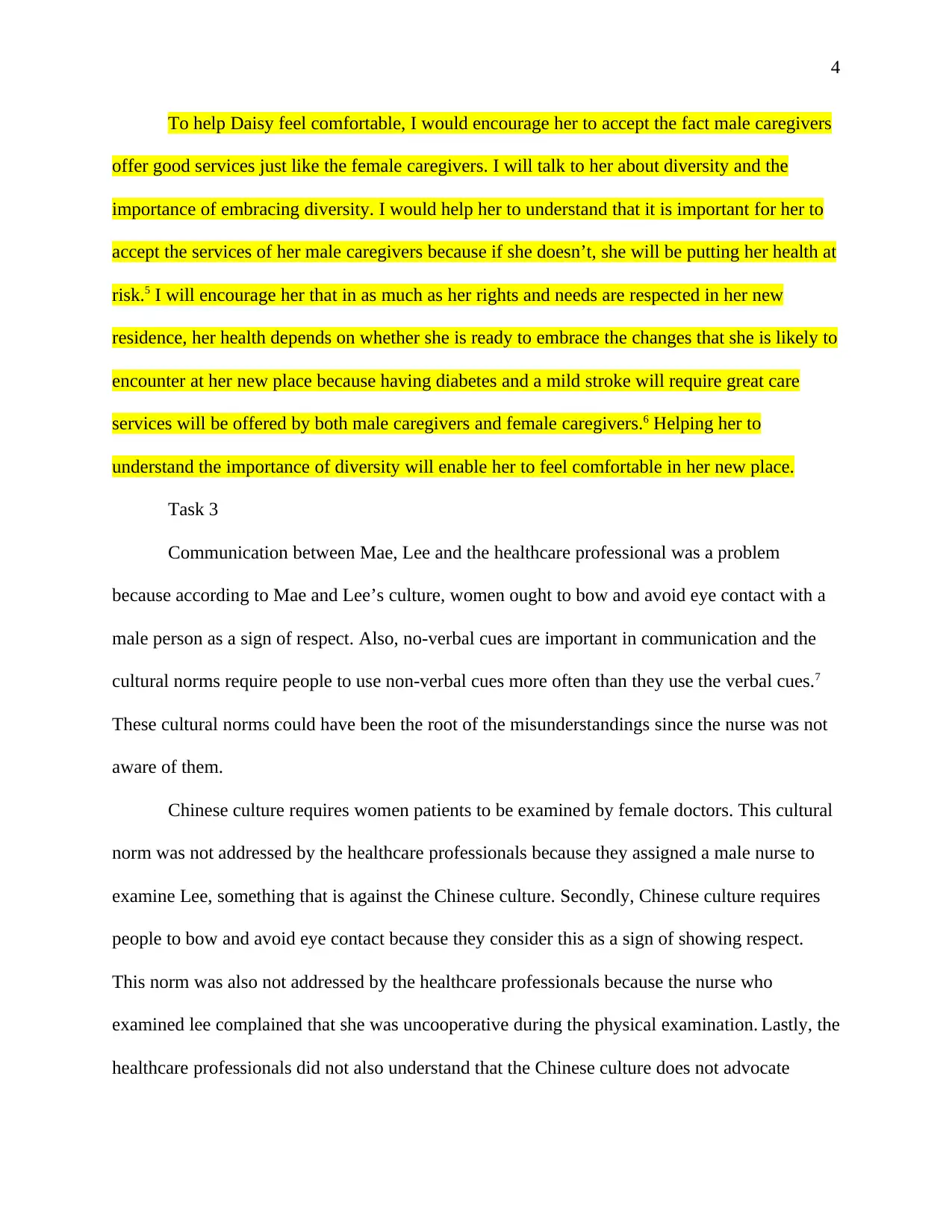
4
To help Daisy feel comfortable, I would encourage her to accept the fact male caregivers
offer good services just like the female caregivers. I will talk to her about diversity and the
importance of embracing diversity. I would help her to understand that it is important for her to
accept the services of her male caregivers because if she doesn’t, she will be putting her health at
risk.5 I will encourage her that in as much as her rights and needs are respected in her new
residence, her health depends on whether she is ready to embrace the changes that she is likely to
encounter at her new place because having diabetes and a mild stroke will require great care
services will be offered by both male caregivers and female caregivers.6 Helping her to
understand the importance of diversity will enable her to feel comfortable in her new place.
Task 3
Communication between Mae, Lee and the healthcare professional was a problem
because according to Mae and Lee’s culture, women ought to bow and avoid eye contact with a
male person as a sign of respect. Also, no-verbal cues are important in communication and the
cultural norms require people to use non-verbal cues more often than they use the verbal cues.7
These cultural norms could have been the root of the misunderstandings since the nurse was not
aware of them.
Chinese culture requires women patients to be examined by female doctors. This cultural
norm was not addressed by the healthcare professionals because they assigned a male nurse to
examine Lee, something that is against the Chinese culture. Secondly, Chinese culture requires
people to bow and avoid eye contact because they consider this as a sign of showing respect.
This norm was also not addressed by the healthcare professionals because the nurse who
examined lee complained that she was uncooperative during the physical examination. Lastly, the
healthcare professionals did not also understand that the Chinese culture does not advocate
To help Daisy feel comfortable, I would encourage her to accept the fact male caregivers
offer good services just like the female caregivers. I will talk to her about diversity and the
importance of embracing diversity. I would help her to understand that it is important for her to
accept the services of her male caregivers because if she doesn’t, she will be putting her health at
risk.5 I will encourage her that in as much as her rights and needs are respected in her new
residence, her health depends on whether she is ready to embrace the changes that she is likely to
encounter at her new place because having diabetes and a mild stroke will require great care
services will be offered by both male caregivers and female caregivers.6 Helping her to
understand the importance of diversity will enable her to feel comfortable in her new place.
Task 3
Communication between Mae, Lee and the healthcare professional was a problem
because according to Mae and Lee’s culture, women ought to bow and avoid eye contact with a
male person as a sign of respect. Also, no-verbal cues are important in communication and the
cultural norms require people to use non-verbal cues more often than they use the verbal cues.7
These cultural norms could have been the root of the misunderstandings since the nurse was not
aware of them.
Chinese culture requires women patients to be examined by female doctors. This cultural
norm was not addressed by the healthcare professionals because they assigned a male nurse to
examine Lee, something that is against the Chinese culture. Secondly, Chinese culture requires
people to bow and avoid eye contact because they consider this as a sign of showing respect.
This norm was also not addressed by the healthcare professionals because the nurse who
examined lee complained that she was uncooperative during the physical examination. Lastly, the
healthcare professionals did not also understand that the Chinese culture does not advocate
Secure Best Marks with AI Grader
Need help grading? Try our AI Grader for instant feedback on your assignments.
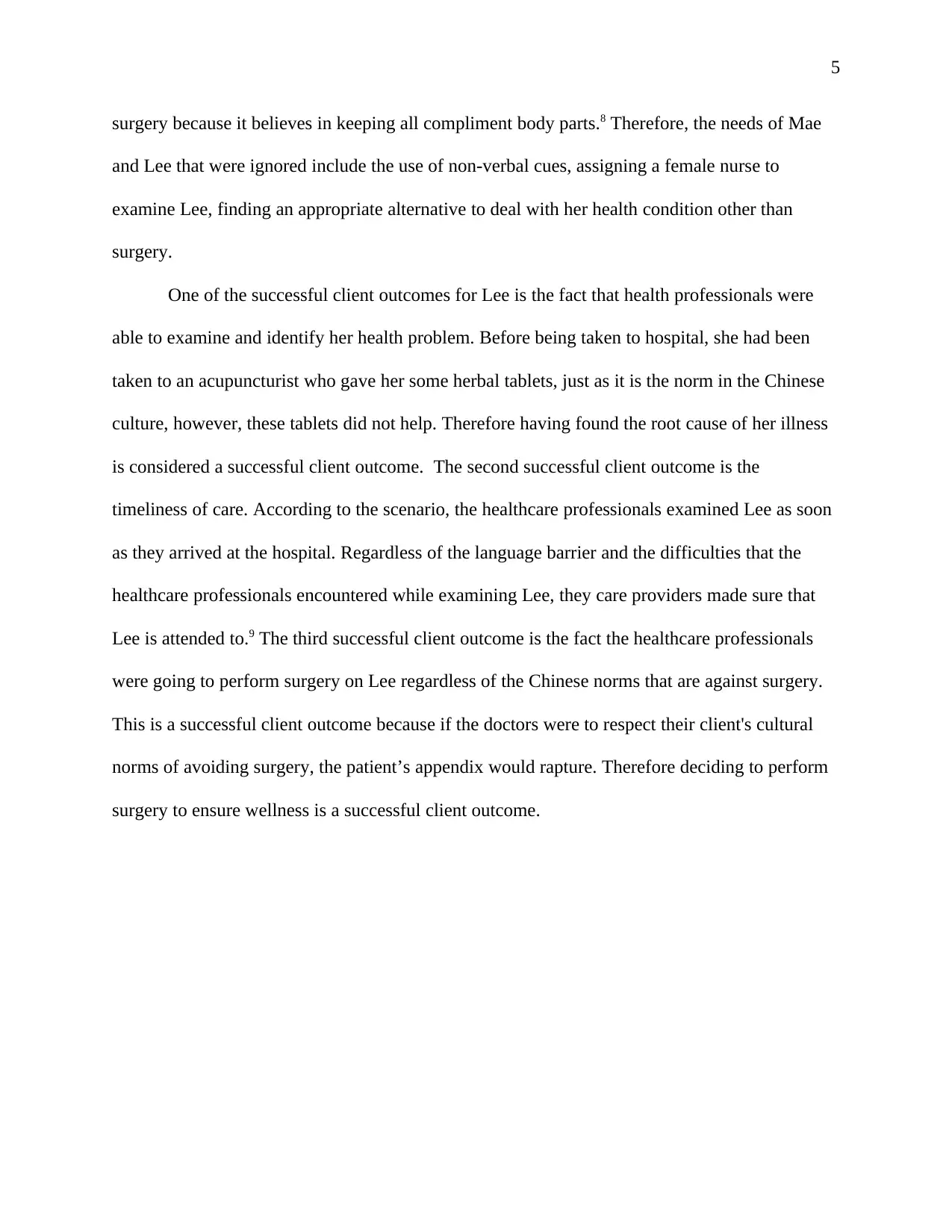
5
surgery because it believes in keeping all compliment body parts.8 Therefore, the needs of Mae
and Lee that were ignored include the use of non-verbal cues, assigning a female nurse to
examine Lee, finding an appropriate alternative to deal with her health condition other than
surgery.
One of the successful client outcomes for Lee is the fact that health professionals were
able to examine and identify her health problem. Before being taken to hospital, she had been
taken to an acupuncturist who gave her some herbal tablets, just as it is the norm in the Chinese
culture, however, these tablets did not help. Therefore having found the root cause of her illness
is considered a successful client outcome. The second successful client outcome is the
timeliness of care. According to the scenario, the healthcare professionals examined Lee as soon
as they arrived at the hospital. Regardless of the language barrier and the difficulties that the
healthcare professionals encountered while examining Lee, they care providers made sure that
Lee is attended to.9 The third successful client outcome is the fact the healthcare professionals
were going to perform surgery on Lee regardless of the Chinese norms that are against surgery.
This is a successful client outcome because if the doctors were to respect their client's cultural
norms of avoiding surgery, the patient’s appendix would rapture. Therefore deciding to perform
surgery to ensure wellness is a successful client outcome.
surgery because it believes in keeping all compliment body parts.8 Therefore, the needs of Mae
and Lee that were ignored include the use of non-verbal cues, assigning a female nurse to
examine Lee, finding an appropriate alternative to deal with her health condition other than
surgery.
One of the successful client outcomes for Lee is the fact that health professionals were
able to examine and identify her health problem. Before being taken to hospital, she had been
taken to an acupuncturist who gave her some herbal tablets, just as it is the norm in the Chinese
culture, however, these tablets did not help. Therefore having found the root cause of her illness
is considered a successful client outcome. The second successful client outcome is the
timeliness of care. According to the scenario, the healthcare professionals examined Lee as soon
as they arrived at the hospital. Regardless of the language barrier and the difficulties that the
healthcare professionals encountered while examining Lee, they care providers made sure that
Lee is attended to.9 The third successful client outcome is the fact the healthcare professionals
were going to perform surgery on Lee regardless of the Chinese norms that are against surgery.
This is a successful client outcome because if the doctors were to respect their client's cultural
norms of avoiding surgery, the patient’s appendix would rapture. Therefore deciding to perform
surgery to ensure wellness is a successful client outcome.
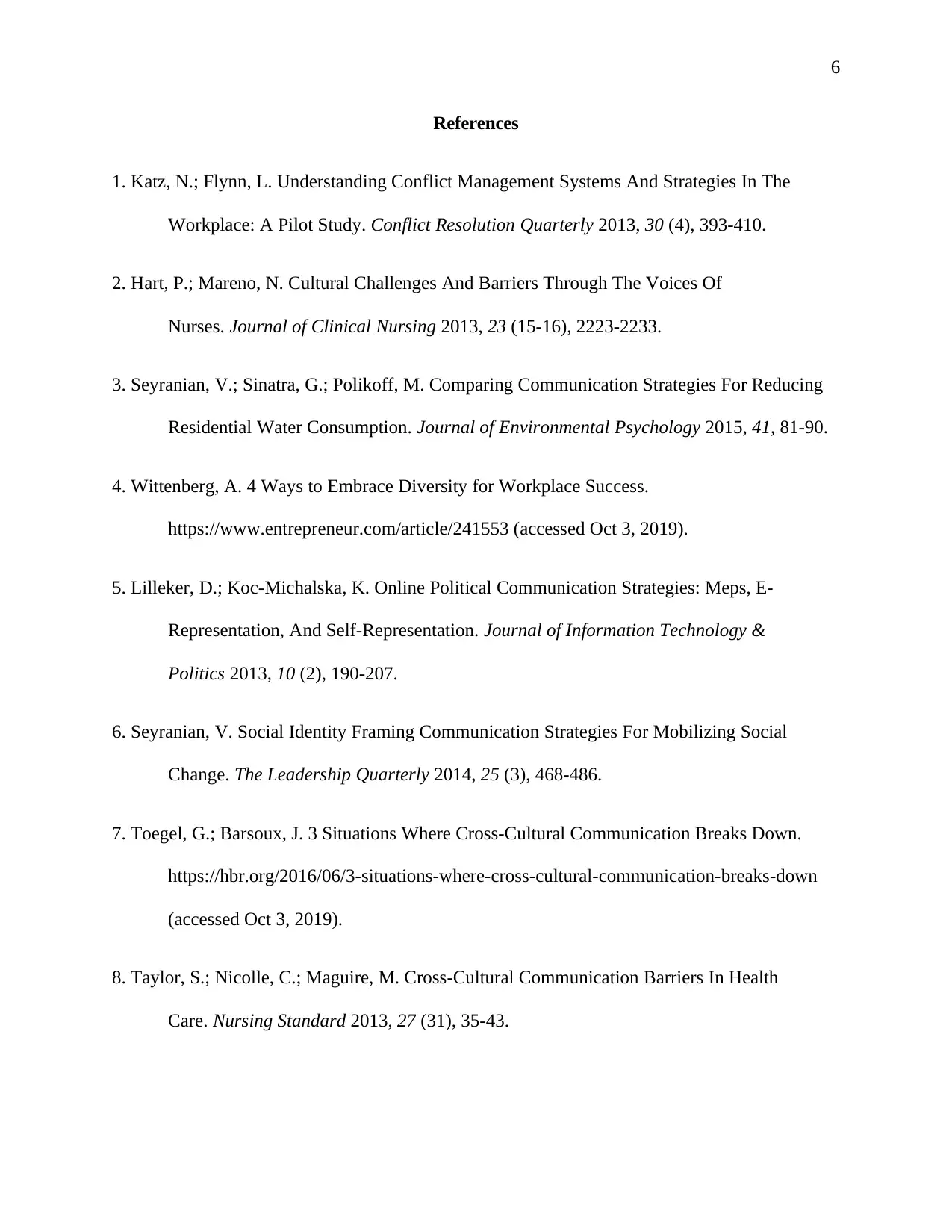
6
References
1. Katz, N.; Flynn, L. Understanding Conflict Management Systems And Strategies In The
Workplace: A Pilot Study. Conflict Resolution Quarterly 2013, 30 (4), 393-410.
2. Hart, P.; Mareno, N. Cultural Challenges And Barriers Through The Voices Of
Nurses. Journal of Clinical Nursing 2013, 23 (15-16), 2223-2233.
3. Seyranian, V.; Sinatra, G.; Polikoff, M. Comparing Communication Strategies For Reducing
Residential Water Consumption. Journal of Environmental Psychology 2015, 41, 81-90.
4. Wittenberg, A. 4 Ways to Embrace Diversity for Workplace Success.
https://www.entrepreneur.com/article/241553 (accessed Oct 3, 2019).
5. Lilleker, D.; Koc-Michalska, K. Online Political Communication Strategies: Meps, E-
Representation, And Self-Representation. Journal of Information Technology &
Politics 2013, 10 (2), 190-207.
6. Seyranian, V. Social Identity Framing Communication Strategies For Mobilizing Social
Change. The Leadership Quarterly 2014, 25 (3), 468-486.
7. Toegel, G.; Barsoux, J. 3 Situations Where Cross-Cultural Communication Breaks Down.
https://hbr.org/2016/06/3-situations-where-cross-cultural-communication-breaks-down
(accessed Oct 3, 2019).
8. Taylor, S.; Nicolle, C.; Maguire, M. Cross-Cultural Communication Barriers In Health
Care. Nursing Standard 2013, 27 (31), 35-43.
References
1. Katz, N.; Flynn, L. Understanding Conflict Management Systems And Strategies In The
Workplace: A Pilot Study. Conflict Resolution Quarterly 2013, 30 (4), 393-410.
2. Hart, P.; Mareno, N. Cultural Challenges And Barriers Through The Voices Of
Nurses. Journal of Clinical Nursing 2013, 23 (15-16), 2223-2233.
3. Seyranian, V.; Sinatra, G.; Polikoff, M. Comparing Communication Strategies For Reducing
Residential Water Consumption. Journal of Environmental Psychology 2015, 41, 81-90.
4. Wittenberg, A. 4 Ways to Embrace Diversity for Workplace Success.
https://www.entrepreneur.com/article/241553 (accessed Oct 3, 2019).
5. Lilleker, D.; Koc-Michalska, K. Online Political Communication Strategies: Meps, E-
Representation, And Self-Representation. Journal of Information Technology &
Politics 2013, 10 (2), 190-207.
6. Seyranian, V. Social Identity Framing Communication Strategies For Mobilizing Social
Change. The Leadership Quarterly 2014, 25 (3), 468-486.
7. Toegel, G.; Barsoux, J. 3 Situations Where Cross-Cultural Communication Breaks Down.
https://hbr.org/2016/06/3-situations-where-cross-cultural-communication-breaks-down
(accessed Oct 3, 2019).
8. Taylor, S.; Nicolle, C.; Maguire, M. Cross-Cultural Communication Barriers In Health
Care. Nursing Standard 2013, 27 (31), 35-43.
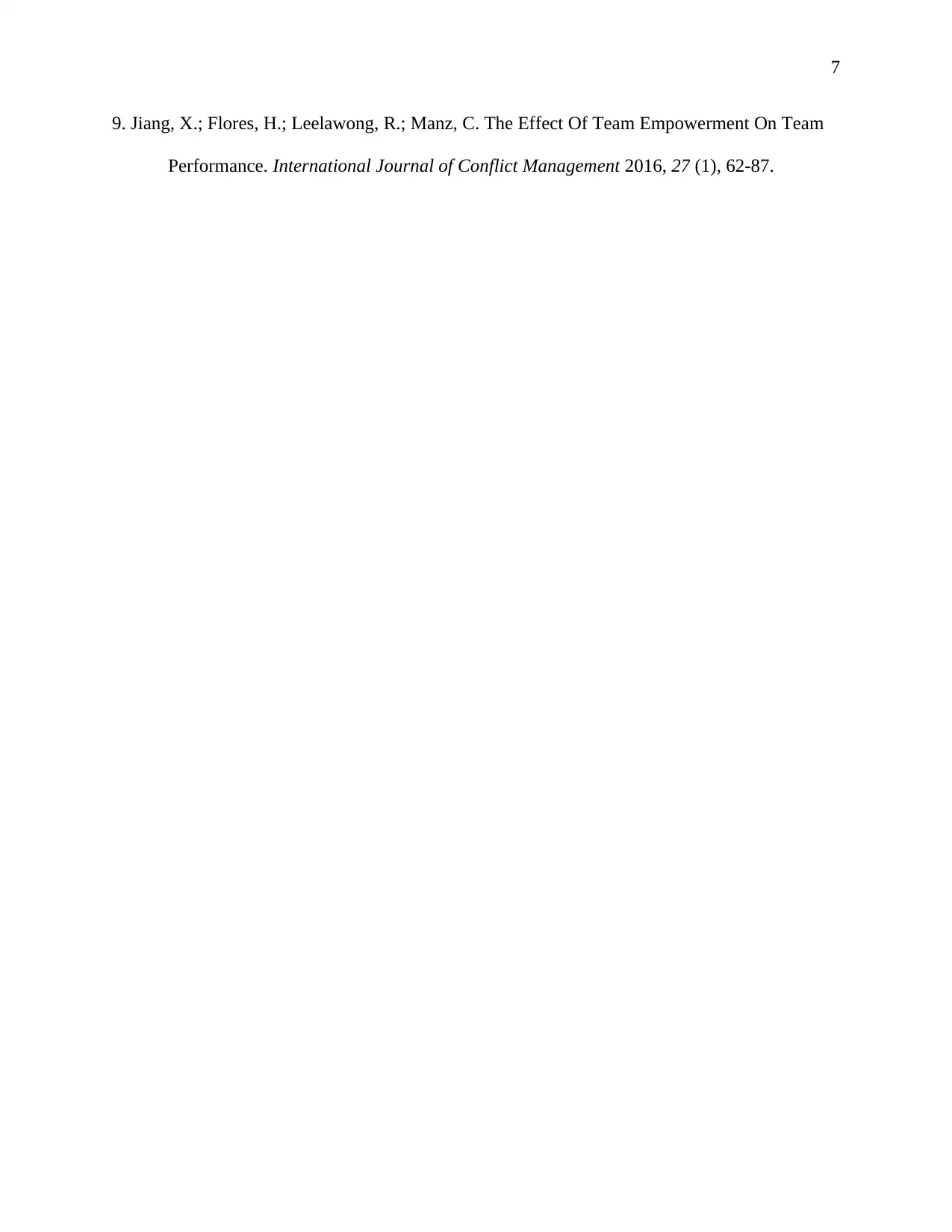
7
9. Jiang, X.; Flores, H.; Leelawong, R.; Manz, C. The Effect Of Team Empowerment On Team
Performance. International Journal of Conflict Management 2016, 27 (1), 62-87.
9. Jiang, X.; Flores, H.; Leelawong, R.; Manz, C. The Effect Of Team Empowerment On Team
Performance. International Journal of Conflict Management 2016, 27 (1), 62-87.
1 out of 7
Your All-in-One AI-Powered Toolkit for Academic Success.
+13062052269
info@desklib.com
Available 24*7 on WhatsApp / Email
![[object Object]](/_next/static/media/star-bottom.7253800d.svg)
Unlock your academic potential
© 2024 | Zucol Services PVT LTD | All rights reserved.

